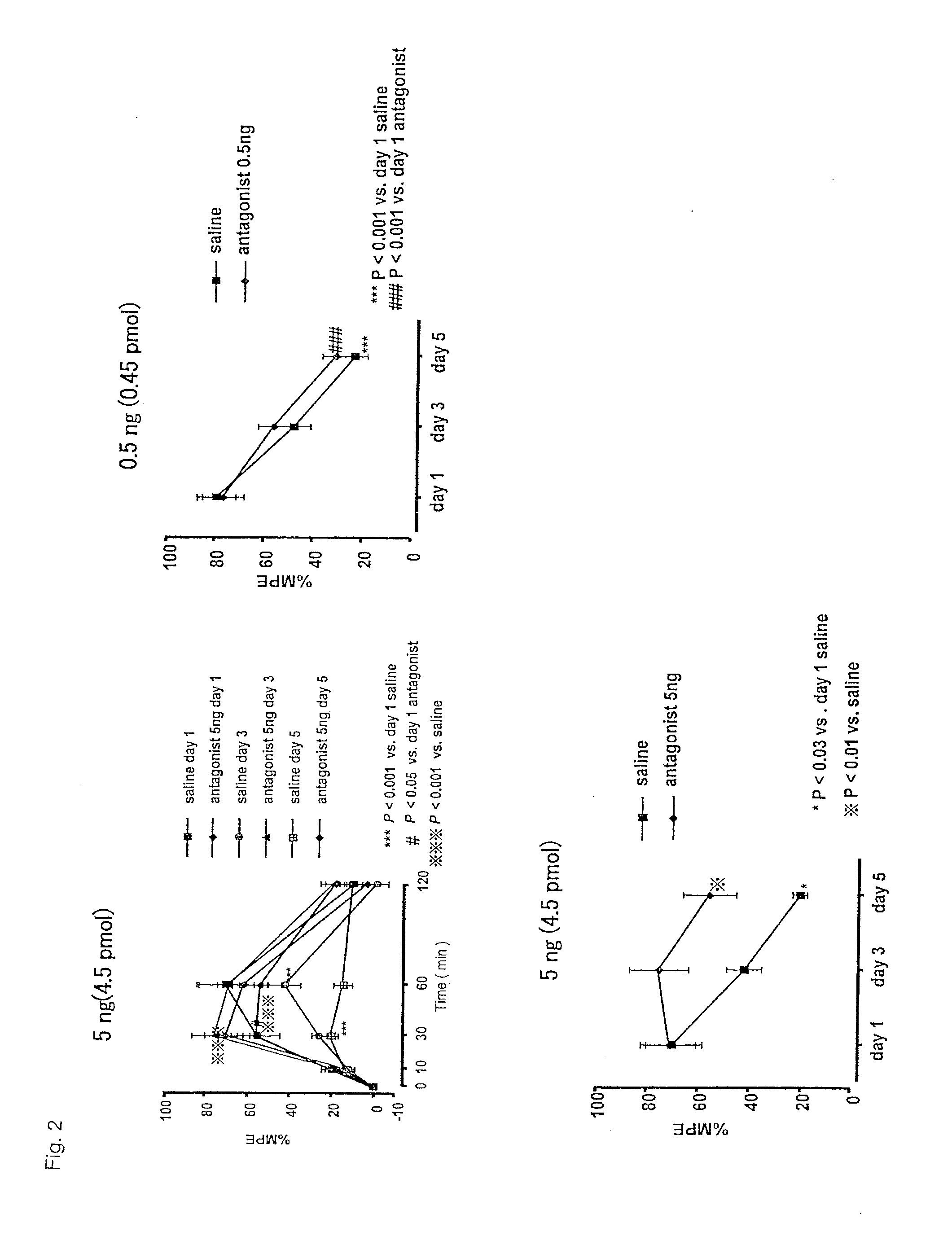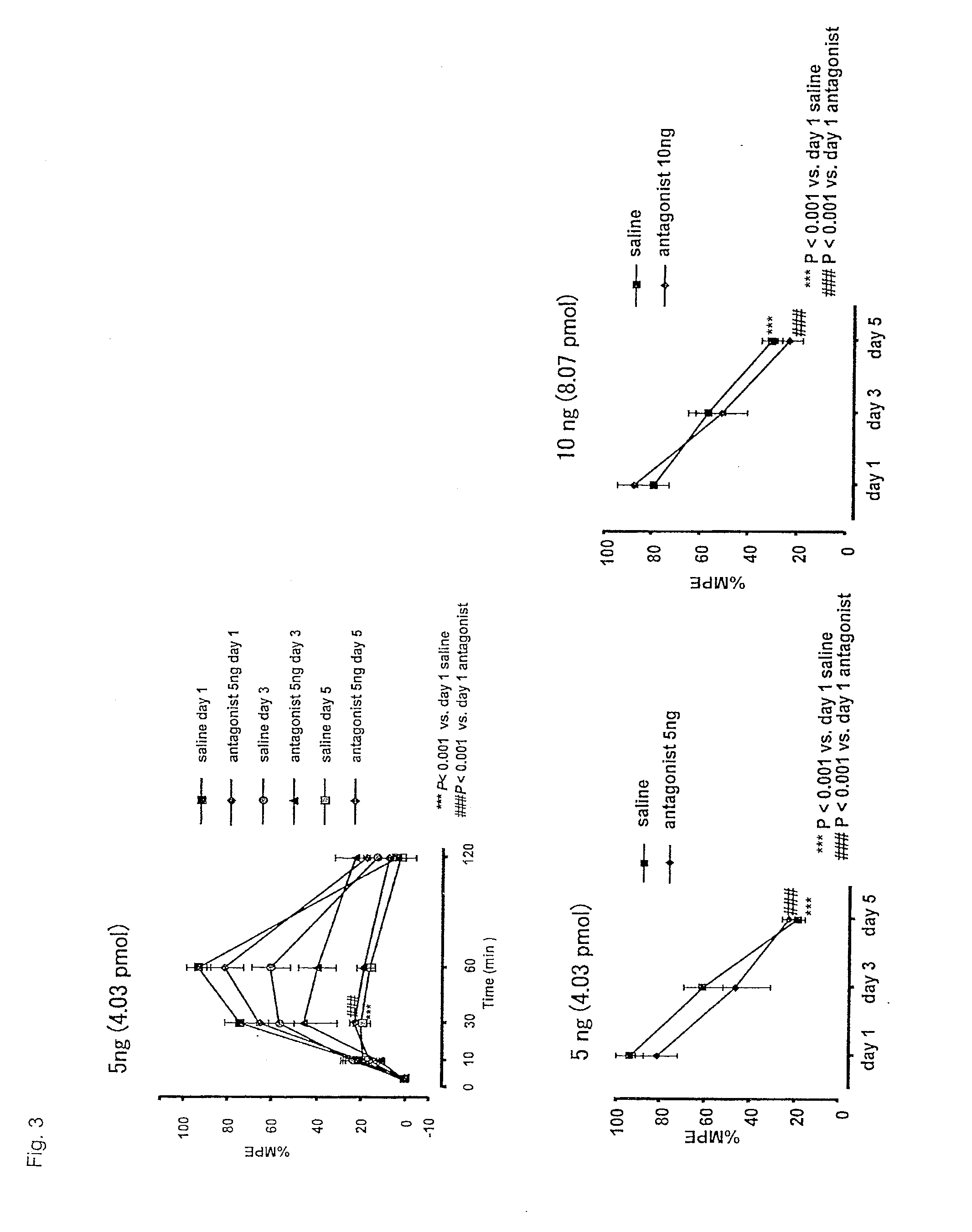Agent for suppressing development of tolerance to narcotic analgesics
a technology of narcotic analgesics and agents, which is applied in the field of drugs for suppressing the development of tolerance to narcotic analgesics, can solve the problems of not being able to report on the effectiveness of vsub>1b /sub>receptors, many functions of vsub>1b /sub>receptors remain unrevealed, and the action of suppressing the development of tolerance to analgesi
- Summary
- Abstract
- Description
- Claims
- Application Information
AI Technical Summary
Benefits of technology
Problems solved by technology
Method used
Image
Examples
example 1
[0030]V1a receptor knockout mice (Neuroscience Letters, 356, pp. 195-198, 2004), V1b receptor knockout mice (J. Clin. Invest., 113, pp. 302-309, 2004), and control mice (body weight: about 30 g) were subcutaneously (s.c.) given with 10 mg / kg of morphine hydrochloride once a day, which was repeated for 15 days. The analgesic effect was evaluated by the tail-flick test on 1st, 5th, 9th, 12th and 15th days after the administration on the basis of the maximal possible effect (% MPE), which represents analgesic intensity and is calculated in accordance with the following equation.
% MPE=100×[(Measured value after treatment−Measured value before treatment)+(Cut-off value−Measured value before treatment)]
[0031]As a result, it was found that tolerance to morphine was developed in the V1a receptor knockout mice and the control mice, whereas remarkable resistance against tolerance to morphine was observed in the V1b receptor knockout mice. The results are shown in FIG. 1. These results suggest...
example 2
[0032]Male ddY mice (5- or 6-week old) were intracerebroventricularly (i.c.v.) given with 5 μl of physiological saline or a V1 receptor antagonist (0.5, 5 or 10 ng), and immediately after the administration, the mice were subcutaneously given with 10 mg / kg of morphine hydrochloride, which was repeated twice a day for 5 days to induce tolerance to morphine analgesic. The analgesic effect was evaluated by the tail-flick test on 1st, 3rd and 5th days after the administration on the basis of intensity of analgesic effect using % MPE and AUC (area under the time-reaction curve, Area Under the Curve). As the V1 receptor antagonist, the following three types of antagonists were used.
[0033](a) PhAcALVP ([phenylacetyl, O-Me-D-Try, Arg, Lys]-vasopressin amide):
[0034]Antagonist highly selective to the V1a receptor
[0035](b) d(CH2)5Tyr(Me)AVP ([β-mercapto-β,β-cyclopentamethylenepropionyl, O-Me-Tyr, Arg]-vasopressin): Antagonist of the V1a receptor
[0036](c) dPenTyr(Me)AVP (deamino-Pen, O-Me-Tyr, ...
example 3
[0040]Effect on development of tolerance to morphine-induced analgesic effect was examined by using an antagonist selective to the V1b receptor, (2S,4R)-1-[5-chloro-1-[2,4-dimethoxyphenyl]sulfonyl]-3-(2-methoxyphenyl)-2-oxo-2,3-dihydro-1H-indol-3-yl]-4-hydroxy-N,N-dimethyl-2-pyrrolidine carboxamine (SSR149415, The Journal of Pharmacology Experimental Therapeutics, 300, pp. 1122-1130, 2002). In combination with morphine (10 mg / kg, s.c.), ddy mice were given with a solvent (1% DMSO in physiological saline, i.c.v.) or a V1b antagonist (i.c.v.) twice a day (at 9:00 and 17:00) for 4 days. The analgesic effect was determined by the tail-flick test (TailFlick Unit, UgoBasile, Milano, Italy). The analgesic effect of morphine (10 mg / kg, s.c.) was observed after the first administration of morphine on the 1st, 3rd, and 5th days. Intensity of the heat source was set so that the reference reaction time became 2 or 3 seconds. Cut-off time was set to be 10 seconds so that possible damage to the c...
PUM
| Property | Measurement | Unit |
|---|---|---|
| body weight | aaaaa | aaaaa |
| affinity | aaaaa | aaaaa |
| body weight | aaaaa | aaaaa |
Abstract
Description
Claims
Application Information
 Login to View More
Login to View More - R&D
- Intellectual Property
- Life Sciences
- Materials
- Tech Scout
- Unparalleled Data Quality
- Higher Quality Content
- 60% Fewer Hallucinations
Browse by: Latest US Patents, China's latest patents, Technical Efficacy Thesaurus, Application Domain, Technology Topic, Popular Technical Reports.
© 2025 PatSnap. All rights reserved.Legal|Privacy policy|Modern Slavery Act Transparency Statement|Sitemap|About US| Contact US: help@patsnap.com



